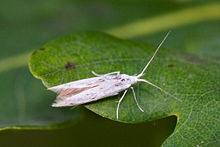Coleophoridae
| Case-bearers | |
|---|---|

| |
| Adult of an unidentified case-bearer species | |
| Scientific classification | |
| Domain: | Eukaryota |
| Kingdom: | Animalia |
| Phylum: | Arthropoda |
| Class: | Insecta |
| Order: | Lepidoptera |
| Infraorder: | Heteroneura |
| Clade: | Eulepidoptera |
| Clade: | Ditrysia |
| Clade: | Apoditrysia |
| Superfamily: | Gelechioidea |
| Family: | Coleophoridae Hübner, [1825] |
| Diversity | |
| Over 1,000 species | |
The Coleophoridae are a
Palearctic, and rare in sub-Saharan Africa, South America, and Australia; consequently, they probably originated (like most or all other Gelechioidea families) in northern Eurasia. They are relatively common in houses, they seek out moist areas to rest and procreate.[1]
Description and ecology
These "
micromoths" are generally of slender build, and like in many of their relatives, the margins of their wings usually consist of a "fringe" of hairs. The tiny caterpillar larvae initially feed internally on the leaves, flowers, or seeds of their host plants. When they emerge to feed externally, they usually construct a protective silken case, discarded and built anew as they grow and molt
. The common names of the Coleophoridae refer to this habit.
The
neotenous
as female bagworms usually are.
Taxonomy and systematics
About 95% of the over 1,000 described
wastebin genus" Coleophora. Many proposals have been made to split smaller genera from Coleophora, but few have been accepted, due to the uncertainties about which species are closest to the type species of Coleophora – C. anatipennella – and thus would remain in the genus.[2]
Regarding the family's circumscription versus other Gelechioidea, it is by now far less disputed than usual for this superfamily. The
subfamilies, but are more often considered separate families today. With the internal relationships of Coleophoridae genera (as far as they are widely accepted) and species essentially unresolved due to the classification problems mentioned above, no subfamilies or tribes are accepted in the family for the time being.[3]
Genera
Genera of case-bearers at least provisionally accepted by recent authors include:[4]
- Amblyxena[5]
- Augasma
- Coleophora
- Corythangela (Batrachedridae)
- Enscepastra (Batrachedridae)
- Goniodoma
- Iriothyrsa (Agonoxeninae)
- Ischnophanes
- Ischnopsis (Agonoxeninae)
- Metriotes
- Nasamonica
- Porotica (Agonoxeninae)
See also
References
- ^ AEBR (2008)
- ^ Pitkin & Jenkins (2004), AEBR (2008), and see references in Savela (2010)
- ^ AEBR (2008), ToL (2008), FE (2009), Wikispecies (2009-NOV-29), and see references in Savela (2010)
- ^ AEBR (2008), FE (2009), Wikispecies (2009-NOV-29), and see references in Savela (2010)
- ^ Beccaloni, G.; Scoble, M.; Kitching, I.; Simonsen, T.; Robinson, G.; Pitkin, B.; Hine, A.; Lyal, C., eds. (2003). "Amblyxena". The Global Lepidoptera Names Index. Natural History Museum. Retrieved 2018-12-20.
![]() Data related to Coleophoridae at Wikispecies See also Gelechioidea Talk page for comparison of some approaches to gelechioid systematics and taxonomy.
Data related to Coleophoridae at Wikispecies See also Gelechioidea Talk page for comparison of some approaches to gelechioid systematics and taxonomy.
Further reading
Wikimedia Commons has media related to Coleophoridae.
- Australian Biological Resources Study (2008): Australian Faunal Directory – Coleophoridae. Version of 2008-OCT-09. Retrieved 2010-APR-30.
- Fauna Europaea (2009): Coleophoridae. Version 2.1, 2009-DEC-22. Retrieved 2010-APR-30.
- Pitkin, Brian & Jenkins, Paul (2004): Butterflies and Moths of the World, Generic Names and their Type-species – Coleophora. Version of 2004-NOV-05. Retrieved 2010-APR-30.
- Savela, Markku (2010): Markku Savela's Lepidoptera and some other life forms – Coleophoridae. Version of 2010-FEB-01. Retrieved 2010-APR-30.
- Tree of Life Web Project (2009): Coleophoridae. Version of 2008-MAY-01. Retrieved 2010-APR-30.
